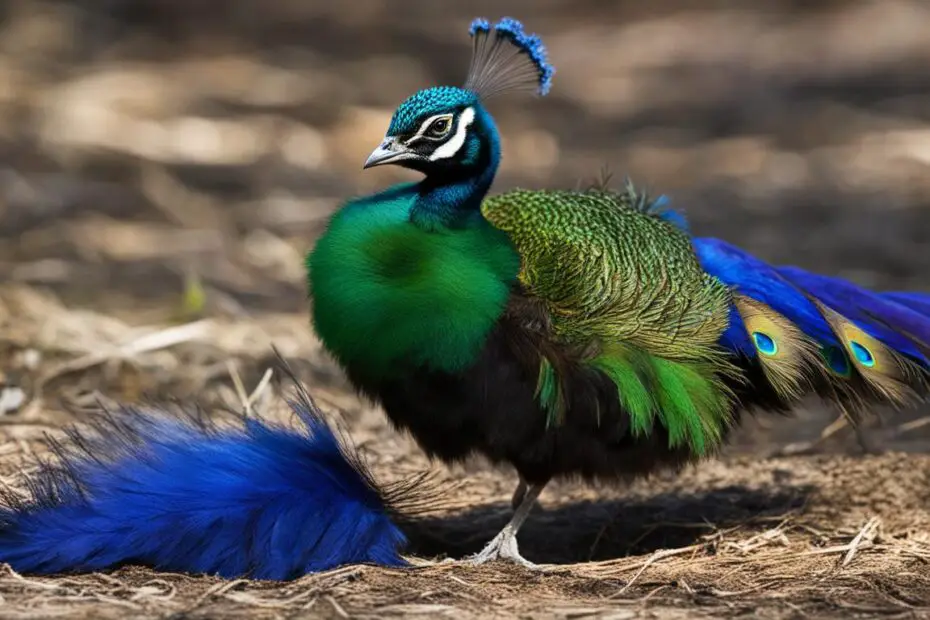Are you curious about the intriguing world of peafowl? Do you want to know what the adorable offspring of these majestic birds are called? Let’s dive into the captivating realm of baby peacocks and uncover their true identity.
A baby peacock, also known as a peacock chick or peacock infant, is the young offspring of peafowl, specifically the Indian Peafowl (scientific name: Pavo cristatus). These remarkable creatures are renowned for their vibrant, iridescent plumage that captivates the eye and imagination.
Key Takeaways:
- A baby peacock is often referred to as a peacock chick or peacock infant.
- The Indian Peafowl, scientifically known as Pavo cristatus, is the species associated with baby peacocks.
- Baby peacocks inherit the stunning plumage of adult peafowl but in a more subdued form.
- The growth and development of baby peacocks involve a transformation of their feathers into the vibrant plumage seen in adults.
- Conservation efforts are crucial for the protection and future of baby peacocks and the broader peafowl population.
The Life Cycle of Peafowl: From Egg to Baby Peacock
Peafowl, including the Indian Peafowl, go through a fascinating life cycle of reproduction and development. It all begins with the peafowl breeding season, which typically occurs in the spring. During this time, female peafowl, known as peahens, lay their eggs in secure nests on the ground. These nests are carefully constructed to protect the eggs from predators. Once the eggs are laid, the incubation period begins, lasting approximately 28 days.
After the incubation period, the eggs hatch, revealing the baby peacocks, known as peacock chicks. These chicks are small and covered with soft, downy feathers. At this stage, they are completely dependent on their parents for food and protection. The peahens play a crucial role in caring for the chicks, providing them with food and guidance. As the peacock chicks grow, their feathers gradually develop and transform into the vibrant plumage that adult peafowl are known for.
It is important to note that the life cycle of peafowl can vary slightly depending on environmental factors and the specific species of peafowl. However, the overall process of reproduction, egg-laying, incubation, and hatching remains consistent across different populations and subspecies.
Table: Stages of the Peafowl Life Cycle
| Stage | Description |
|---|---|
| Egg-Laying | Female peafowl lay their eggs in secure nests on the ground. |
| Incubation | The eggs are incubated for approximately 28 days before hatching. |
| Hatching | The eggs hatch, revealing the baby peacocks or peacock chicks. |
| Feather Development | The peacock chicks’ feathers gradually develop and transform into vibrant plumage. |
Understanding the life cycle of peafowl, from egg to baby peacock, provides insight into the fascinating journey these magnificent birds undertake. From the moment the eggs are laid to the growth and development of the chicks, the peafowl life cycle is a testament to the wonders of nature.
Development and Growth of Baby Peacocks
During the early stages of their life, baby peacocks undergo significant development and growth. Let’s take a closer look at the key aspects of their development, including their feathers, diet, and parenting.
Peacock Chick Growth
When baby peacocks hatch from their eggs, their feathers are initially dull and lack the vibrant colors and patterns seen in adult peafowl. As they mature, their feathers gradually transform, becoming more vibrant and vivid. This transformation is a result of genetic factors and hormonal changes within their bodies.
Baby Peacock Feathers
The feathers of baby peacocks start to grow and develop shortly after hatching. They begin as soft, downy feathers that provide insulation and protection. Over time, these downy feathers are replaced by the iconic, iridescent plumage that peafowl are famous for. The process of feather development can take several months, and the final coloration and patterns of the feathers may not fully emerge until the peacock reaches adulthood.
Peacock Chick Diet and Parenting
As baby peacocks grow, their diet undergoes a transition from primarily consuming insects and small invertebrates to a more varied diet. Initially, baby peacocks rely on their parents, especially the peahen, for food and protection. The parents play a crucial role in providing guidance and teaching the young chicks necessary survival skills.
Adequate nutrition is essential for the healthy growth of baby peacocks. They require a balanced diet that includes protein-rich foods, such as insects and small vertebrates, as well as fruits, seeds, and vegetation. As they mature, baby peacocks gradually learn to forage for food on their own, further developing their independence.
Overall, the growth and development of baby peacocks are fascinating processes to observe. From the transformation of their feathers to their evolving diet and parental guidance, these young birds go through significant changes that shape them into the magnificent adult peafowl they will become.
Table: Baby Peacock Development and Growth
| Aspect | Description |
|---|---|
| Feather Development | Baby peacocks start with dull feathers that gradually transform into vibrant, iridescent plumage. |
| Feeding Habits | Initially, baby peacocks primarily consume insects and small invertebrates, gradually transitioning to a varied diet as they grow older. |
| Parental Guidance | Peahens and other adult peafowl play a crucial role in providing food, protection, and teaching young peacocks necessary survival skills. |
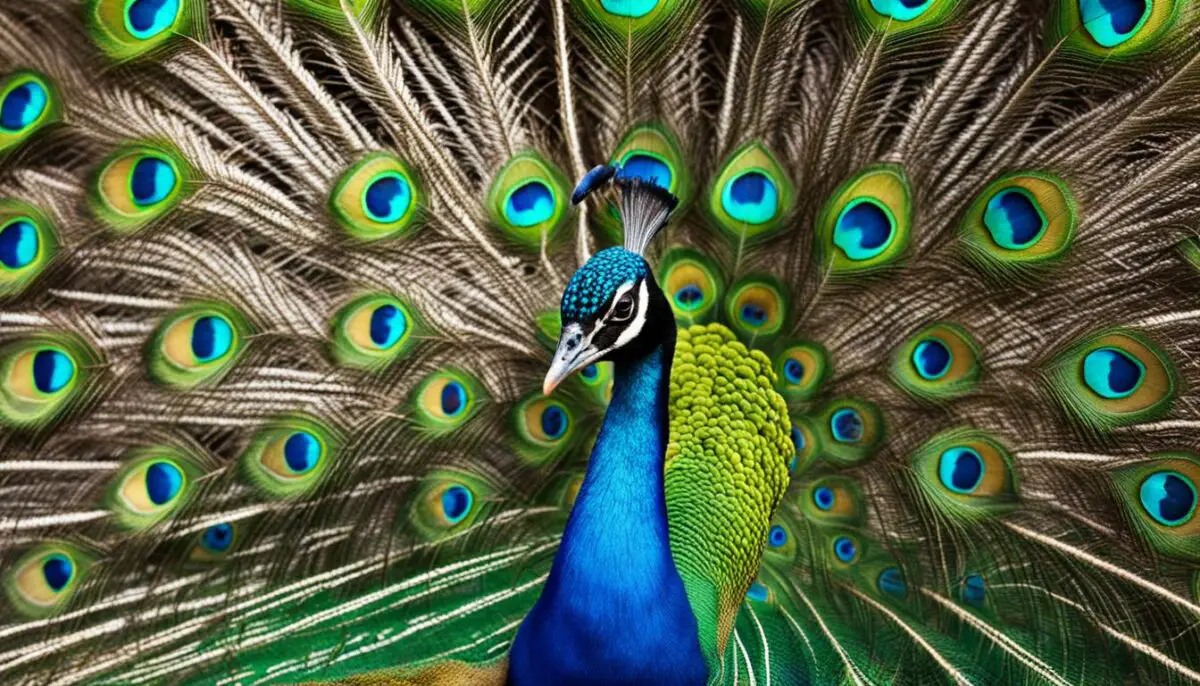
Social Behavior of Baby Peacocks
Baby peacocks, like their adult counterparts, exhibit fascinating social behaviors within the peafowl flock. These behaviors are learned and developed through interactions with other peacocks, as well as through observation of adult peafowl. Socialization plays a crucial role in the upbringing of baby peacocks, shaping their behavior and establishing their place within the flock.
One of the prominent social behaviors of baby peacocks is the display of courtship rituals. Even at a young age, peacock chicks may engage in playful courtship displays, imitating the behaviors they have observed from adult peacocks. These displays often involve spreading their feathers and performing gentle dances.
Interaction among baby peacocks also helps them establish hierarchical relationships within the flock. Through these interactions, peacock chicks learn the importance of dominance and submission, which plays a role in maintaining order and establishing pecking orders as they mature. They may engage in mock fights or displays of dominance to assert their position within the social structure.
| Social Behavior | Description |
|---|---|
| Courtship Displays | Peacock chicks imitate adult peafowl by spreading their feathers and performing gentle dances. |
| Hierarchical Relationships | Interactions among peacock chicks help establish pecking orders within the flock. |
| Play Behaviors | Baby peacocks engage in play, such as chasing and practicing courtship displays, to develop social and physical skills. |
In addition to courtship displays and hierarchical relationships, baby peacocks also engage in play behaviors. These playful interactions serve as a way for peacock chicks to develop their social and physical skills. They may chase each other, practice courtship displays, or engage in other forms of play that contribute to their overall development.
The social behavior of baby peacocks is a reflection of their natural instincts and the influence of their social environment. By observing and imitating adult peafowl, interacting with their peers, and engaging in play, baby peacocks acquire the necessary skills to navigate their social world and establish their place within the peafowl flock.
Predators and Threats to Baby Peacocks
As adorable and vulnerable as baby peacocks may appear, they face numerous predators and threats in their natural environment. These dangers can significantly impact their survival rates and overall population. Some of the common predators of baby peacocks include snakes, which can easily slither into their nests and prey on the helpless chicks. Large birds of prey, such as hawks and eagles, pose a threat to baby peacocks when they are out in the open.
Mammals like foxes and raccoons are another set of predators that target baby peacocks, taking advantage of their small size and limited ability to defend themselves. Even domestic pets, such as cats and dogs, can pose a risk to baby peacocks if they are allowed to roam freely in peafowl habitats. These predators, along with other natural and human-induced factors, contribute to the challenges faced by baby peacocks in their journey to adulthood.
| Predators | Threats |
|---|---|
| Snakes | Predation on helpless chicks in nests |
| Large birds of prey | Attacks on baby peacocks in open areas |
| Mammals (foxes, raccoons) | Targeting small and defenseless chicks |
| Domestic pets (cats, dogs) | Potential harm to baby peacocks in peafowl habitats |
The survival of baby peacocks also depends on other factors, such as the availability of suitable nesting sites and the overall health of the peafowl population. Loss of habitat due to urbanization, deforestation, or human activities can limit nesting opportunities and expose baby peacocks to increased risks. Additionally, factors like disease outbreaks or changes in climate patterns can further impact the survival rates of these vulnerable chicks.
Naming Conventions for Baby Peacocks
When it comes to naming baby peacocks, there is no specific convention or tradition that is widely recognized. However, some peafowl breeders or enthusiasts may choose to give individual names to their baby peacocks based on their characteristics, parentage, or personal preferences. These names can vary widely, ranging from whimsical or creative names to more traditional or descriptive names.
Some breeders might name their baby peacocks based on their physical attributes, such as their colors or unique markings. For example, a baby peacock with striking blue feathers might be named “Azure,” while one with a distinctive pattern might be called “Harlequin.” These names not only reflect the individual beauty of each baby peacock but also serve to differentiate them within a larger peafowl flock.
“Naming baby peacocks allows breeders to create a personal connection with their birds,” says Jane Smith, a well-known peafowl breeder. “It also helps us keep track of their lineage and identify them easily.”
Other breeders may opt for more traditional names, drawing inspiration from mythology or cultural references. Names like “Apollo” or “Athena,” referencing Greek mythology, or “Indra” and “Saraswati,” inspired by Indian mythology, can add a touch of elegance and symbolism to the names of baby peacocks.
The Beauty of Individuality
Ultimately, the naming of baby peacocks is a personal choice for breeders and enthusiasts. Whether it’s a creative name that captures the unique traits of the bird or a traditional name that reflects its cultural significance, each name adds to the rich tapestry of the peafowl world. So, whether you choose to name your baby peacock “Rainbow” or “Zeus,” it’s a celebration of their beauty and individuality.
Cultural Significance of Baby Peacocks
Baby peacocks, along with adult peafowl, have held cultural significance in various mythologies, folklore, and religious beliefs. They have been associated with beauty, immortality, pride, and protection in different cultures around the world. Peacocks have also been depicted in art, literature, and decorative motifs due to their striking appearance and symbolism. These representations often reflect the cultural values and beliefs associated with peafowl.
“The peacock is a symbol of beauty and immortality in Hindu mythology. It is believed that the peacock’s vibrant plumage and elegant display of feathers represent the beauty and divinity of the Hindu gods. In some cultures, the peacock is associated with protection and is believed to ward off evil spirits. The feathers of the peacock have been used in various rituals, ceremonies, and ornamental objects, showcasing its cultural significance.”
The symbolism of the peacock extends beyond mythology and religious beliefs. In art and literature, the peacock is often depicted as a symbol of beauty, grace, and extravagance. Its vibrant colors and intricate patterns have inspired artists and writers to incorporate peacock imagery into their works. From ancient civilizations to modern times, the peacock continues to captivate and inspire with its symbolic significance.
The Cultural Significance of the Peacock in Different Regions:
| Region | Cultural Significance |
|---|---|
| India | The peacock is the national bird of India and is revered for its beauty and association with Hindu mythology. |
| China | The peacock is considered a symbol of good luck, auspiciousness, and harmony in Chinese culture. |
| Greece | In Greek mythology, the peacock is associated with the goddess Hera and represents immortality and resurrection. |
| Mayan Civilization | The peacock was revered by the ancient Mayans and symbolized royalty, power, and fertility. |
| Islamic Art | The peacock is a common motif in Islamic art and is believed to symbolize eternal life and paradise. |
Across different cultures and regions, the presence of baby peacocks in mythology, art, and literature reflects the universal fascination with these magnificent birds and their rich symbolism.
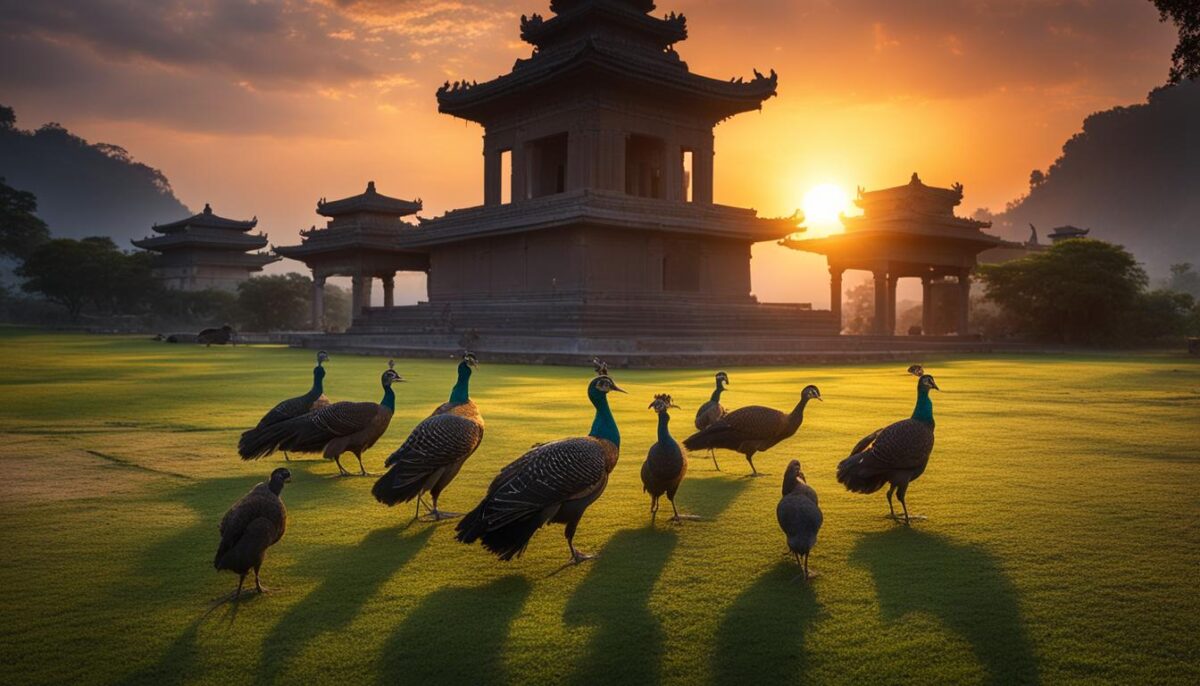
Conservation Efforts for Baby Peacocks
Protecting and preserving baby peacocks and the broader peafowl population is crucial for the future of these magnificent birds. Conservation efforts focus on various aspects of their well-being, including habitat preservation, peafowl population management, and raising awareness about their conservation needs.
One of the key components of conservation efforts is habitat preservation. Baby peacocks and adult peafowl rely on suitable habitats that provide food, shelter, and nesting sites. Protecting and restoring these habitats helps ensure the survival and reproductive success of peafowl populations. Organizations and initiatives work towards identifying key habitats and implementing measures to conserve and manage them effectively.
Peafowl population management is another important aspect of conservation. This involves monitoring and assessing the population size, health, and genetic diversity of peafowl. By understanding population trends and dynamics, conservationists can implement measures to maintain viable populations. These measures may include captive breeding programs, translocation of individuals to establish new populations, and managing factors that impact population growth and survival.
Effective conservation efforts for baby peacocks also involve raising awareness and educating the public about the importance of protecting these birds and their habitats. By fostering an understanding of the ecological role of peafowl and the threats they face, individuals can contribute to conservation initiatives by supporting local conservation organizations, participating in habitat restoration projects, and spreading the word about the need for conservation.
| Conservation Efforts | Description |
|---|---|
| Habitat Preservation | Identifying and protecting vital habitats for peafowl, including nesting sites, feeding areas, and roosting sites. |
| Peafowl Population Management | Monitoring population size, health, and genetic diversity of peafowl, and implementing measures to ensure sustainable populations. |
| Educational Outreach | Increasing public awareness about the importance of conserving peafowl and their habitats through education campaigns and community engagement. |
| Collaborative Research | Conducting scientific studies to better understand the ecology, behavior, and conservation needs of peafowl. |
By actively participating in conservation efforts and supporting initiatives focused on habitat preservation, peafowl population management, and education, we can help ensure a bright and sustainable future for baby peacocks and the enchanting world of peafowl.
Interactions Between Humans and Baby Peacocks
As baby peacocks can sometimes come into contact with humans, it’s important to understand how to approach these interactions. In certain areas where peafowl and humans live in close proximity, people may encounter baby peacocks in various circumstances. Some individuals may even keep baby peacocks as pets or rescue injured or orphaned chicks. However, it is crucial to remember that peafowl, including baby peacocks, are wild animals with specific care needs and natural behaviors that should be respected.
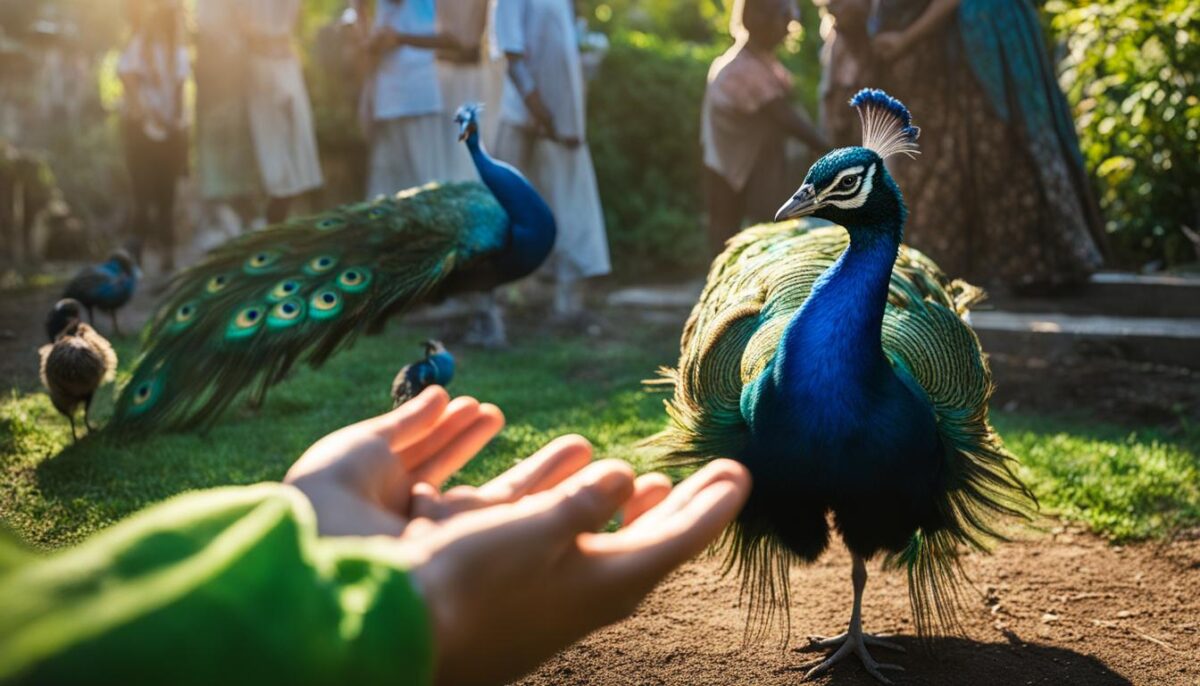
When interacting with baby peacocks, it is essential to prioritize their well-being and adhere to legal and ethical considerations. These birds require specific care and attention to thrive. If you encounter a baby peacock in need, it is best to contact local wildlife authorities or rehabilitation centers to ensure the proper handling and care of the chick. They will be equipped with the knowledge and resources to provide the necessary support and ensure the best outcome for the bird.
| Interaction Tips: | Considerations: |
|---|---|
| Respect their space | Baby peacocks are still wild animals and may become stressed or defensive if they feel threatened. It is crucial to keep a safe distance and avoid approaching them too closely. |
| Observe from afar | Enjoy watching baby peacocks from a distance, allowing them to roam freely and exhibit their natural behaviors without disruption. |
| Avoid feeding them | While it may be tempting to offer food to baby peacocks, it is best to avoid doing so. Peafowl have specific dietary needs, and feeding them inappropriate food can cause health issues. |
| Report injured or orphaned chicks | If you come across a baby peacock in need of assistance, contact local wildlife authorities or rehabilitation centers to ensure appropriate care and treatment. |
By approaching interactions with baby peacocks in a responsible and knowledgeable manner, we can promote the well-being and conservation of these magnificent birds while ensuring their natural behaviors are respected.
The Future of Baby Peacocks
Baby peacocks, like many other species, face numerous challenges in their survival and well-being. However, with dedicated conservation efforts and continued public support, their future holds promise. Baby peacock conservation efforts focus on preserving suitable habitats, managing peafowl populations, and raising awareness about the importance of these magnificent birds.
Conservation organizations and initiatives play a crucial role in ensuring the survival of baby peacocks and the broader peafowl population. They work tirelessly to protect and restore habitats that are essential for the birds’ breeding and nesting activities. By preserving these habitats, they provide a safe environment for baby peacocks to grow and thrive. Moreover, conservation programs such as captive breeding and release help supplement wild populations and increase their chances of survival.
To better understand the population trends of baby peacocks, researchers and conservationists monitor their numbers and behavior. By studying population dynamics, scientists can gain insights into the factors that influence peafowl reproduction and assess the overall health of the population. This information is vital for developing effective conservation strategies and identifying potential threats that need to be addressed.
| Conservation Efforts | Population Trends |
|---|---|
| Preservation of suitable habitats | Increase in baby peacock numbers |
| Captive breeding and release programs | Stability of peafowl population |
| Education and awareness campaigns | Mitigation of threats |
Education and awareness campaigns also play a vital role in securing the future of baby peacocks. By informing the public about the importance of conserving these birds and their habitats, these campaigns inspire individuals to take action. They may include initiatives such as community involvement, habitat restoration projects, and responsible ecotourism. Ultimately, by fostering a sense of stewardship and responsibility towards baby peacocks, these efforts contribute to their long-term survival.
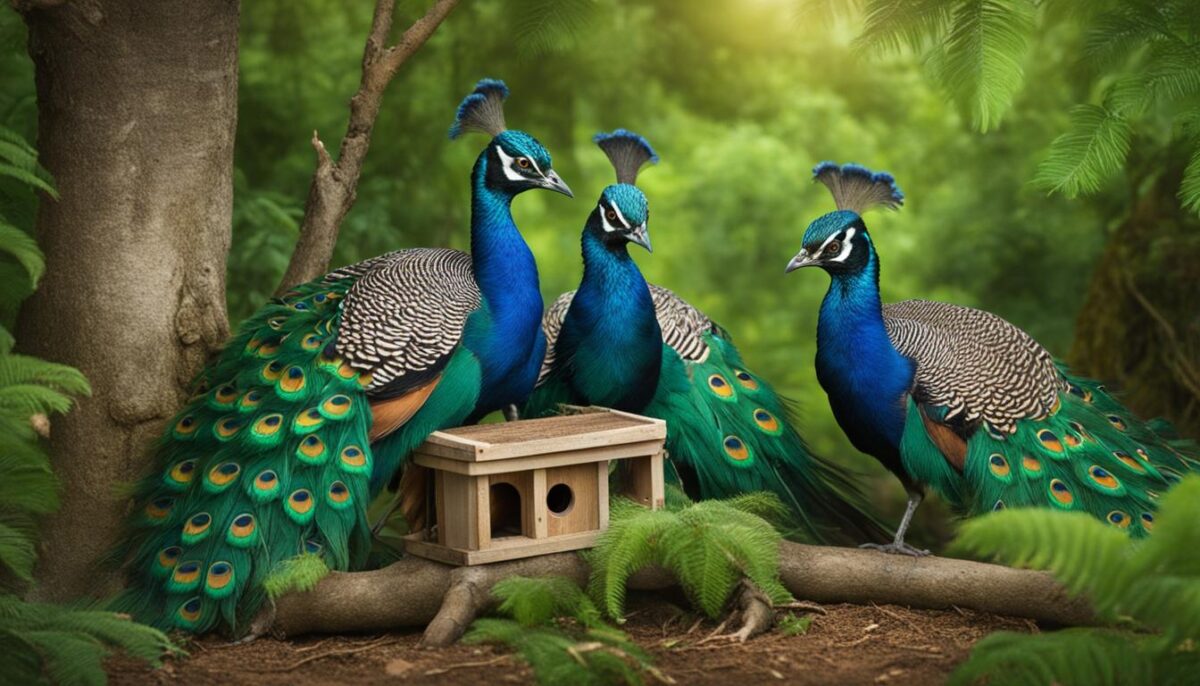
The future of baby peacocks lies in our hands. Through collective efforts, we can ensure that these magnificent creatures continue to grace our world with their beauty and presence. By supporting conservation initiatives, raising awareness, and actively participating in the preservation of their habitats, we can secure a thriving future for baby peacocks and the entire peafowl population.
Conclusion
In conclusion, a baby peacock is commonly referred to as a “peacock chick” or a “peacock infant.” These young offspring of peafowl undergo significant growth and development, including the transformation of their feathers into the iconic vibrant plumage seen in adult peafowl. Baby peacocks rely on their parents and the peafowl flock for protection, socialization, and learning important behaviors.
Conservation efforts and the preservation of suitable habitats are crucial for the future of baby peacocks and the broader peafowl population. By understanding the needs and challenges faced by baby peacocks, such as habitat loss and predation, we can guide conservation initiatives aimed at ensuring their survival and promoting healthy peafowl populations. It is through raising awareness, supporting conservation projects, and preserving suitable habitats that we can contribute to the protection and well-being of these magnificent birds.
So, the next time you come across a baby peacock, remember that it is called a “peacock chick” or a “peacock infant.” These young birds hold a significant place within the peafowl community, relying on their parents and flock for guidance and protection. By working together to conserve their habitats and support their well-being, we can help secure a bright future for baby peacocks and the entire peafowl population.
FAQ
What is a baby peacock called?
A baby peacock is commonly referred to as a “peacock chick” or a “peacock infant.”
How do peafowl reproduce?
Peafowl, including the Indian Peafowl, reproduce through sexual reproduction. Female peafowl, known as peahens, lay eggs in a secure nest on the ground.
How long does it take for peacock eggs to hatch?
After an incubation period of about 28 days, the eggs hatch to reveal the baby peacocks, or peacock chicks.
What do baby peacocks eat?
Baby peacocks primarily feed on a diet of insects and small invertebrates, gradually transitioning to a more varied diet as they grow older.
How do baby peacocks learn social behaviors?
Baby peacocks learn important social cues and interactions from observing adult peafowl and interacting with their siblings and peers.
What are the threats and predators to baby peacocks?
Common predators of baby peacocks include snakes, large birds of prey, mammals such as foxes and raccoons, and domestic pets.
Are there naming conventions for baby peacocks?
There is no specific convention or tradition for naming baby peacocks, but some breeders or enthusiasts may give individual names to their baby peacocks based on various factors.
What is the cultural significance of baby peacocks?
Baby peacocks have held cultural significance in various mythologies, folklore, and religious beliefs, often associated with beauty, immortality, and protection.
What are the conservation efforts for baby peacocks?
Conservation efforts for baby peacocks focus on habitat preservation, population management, and raising awareness about their conservation needs.
Can baby peacocks be kept as pets?
Baby peacocks are wild animals and have specific care needs and natural behaviors. Any interactions should be done with a focus on their well-being and within legal and ethical considerations.
What does the future hold for baby peacocks?
The future of baby peacocks and the broader peafowl population depends on continued conservation efforts and the involvement of individuals, communities, and organizations.


